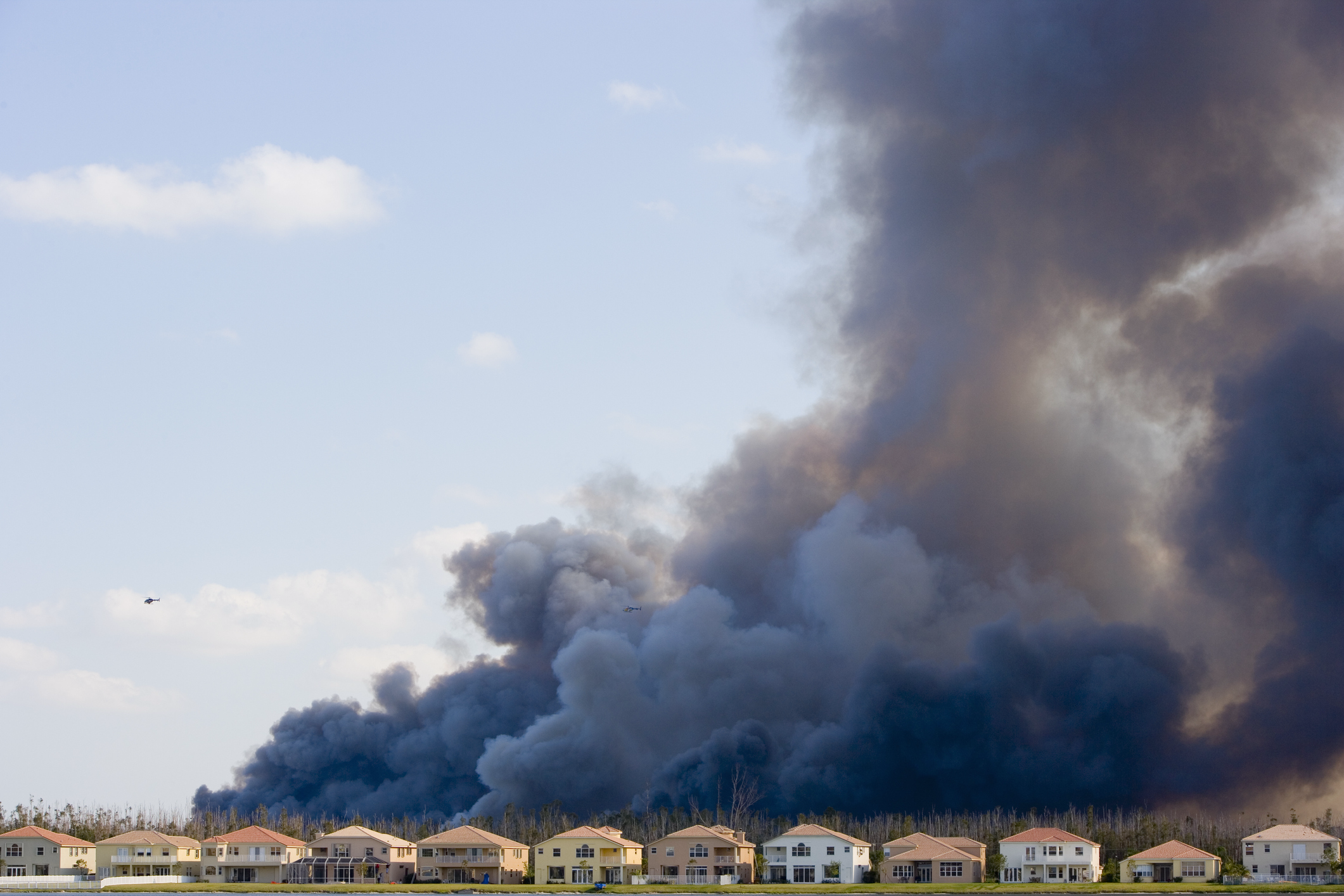In May 2023, California’s largest home insurer State Farm announced that it would pause issuing policies in the state due to growing wildfire risk. Allstate followed shortly after. Next came an announcement from Farmers Insurance: it would be doing the same in Florida due to hurricane risk. And in January 2024, newly proposed rate increases in North Carolina mean, if passed, homeowners could see an average increase in insurance costs of about 42 percent across the state, with coastal communities seeing much higher rates.
The combination of climate change and growing development pressure in disaster-prone areas is intensifying the risks to people and infrastructure from natural disasters. As noted in NLC’s Energy, Environment, and Natural Resources Committee’s 2023 policy and resolutions, insurance companies are already accounting for higher risk of damage to property in their assessments for insurance policies. As insurance companies either raise prices to account for these increased risks, decline new policies in certain areas or withdraw altogether from states with the most natural disasters, residents across the country will be faced with the difficult decision to either pay exorbitant insurance costs or leave their homes and communities to relocate.
Understanding how climate change is impacting the insurance industry’s operations and pricing models will enable municipal leaders to support their residents in obtaining affordable and appropriate home and rental insurance as prices and risks increase.
A 2021 study by global insurance company AXA revealed that approximately 60 percent of surveyed risk managers feared climate change would make certain areas or activities uninsurable.
Locally, an analysis of multifamily properties in California highlights this phenomenon, noting many examples of price increases for multifamily properties providing critical housing and social services. One case study of an affordable housing community serving older adults in Santa Clara County showed an increase in insurance costs of more than 300 percent between 2020 and 2023.
This increase in insurance prices will impact certain demographics in a community more significantly. Residents who own their home outright or can buy a home without a mortgage can self-insure while those requiring a mortgage or who rent are beholden to fluctuating insurance prices. Many low- to middle-income residents and residents on fixed incomes who hold a mortgage may be forced to sell and relocate to areas with lower insurance premiums as the cost of insurance continues to increase. Renters are disproportionately feeling the impact as the cost of insurance is passed on from the property owner to the renter. As the insurance landscape changes, communities may lose residents, particularly those who make up the working class, leading to cascading impacts for economies that rely on certain types of industries like tourism and retail. Some researchers predict a tipping point where house rich, cash poor residents become trapped in high-risk areas that become uninsurable due to repeated natural disasters.
Assessing Climate Change and Housing Across the Country
Some municipalities are already implementing solutions to reduce growing climate risk to housing.
Retreating from Wildfires in Paradise, CA
Paradise, CA, devastated by the 2018 Camp Fire that killed 85 people and destroyed 19,000 structures, is one of the first documented cases of wildfire-induced voluntary retreat, with only a third of the pre-fire population remaining. Decades of community efforts to reduce flammability of the surrounding wildlands and create firebreaks have failed to halt fire from spreading.
The City of Paradise proposed a voluntary buyout program funded by nonprofit grant money and donations as one solution for the Camp Fire recovery. The effort identifies high risk properties and, if homeowners are willing, the city purchases their land to convert into fire-resistant green spaces. Voluntary buyouts are a difficult process, as people who opt-in must walk away from economic and emotional ties to their communities. In addition, voluntary buyouts alone do not address community-wide insurance affordability challenges and availability of affordable housing. This challenge deepens in California since residents often moved to Paradise because of unaffordability elsewhere in the state. Although the cost of housing continues to increase for those who remain in Paradise, the community is rebuilding and striving towards becoming one of the country’s most wildfire-prepared towns with the only wildfire-prepared home standard in the country.
After the Camp Fire ravaged Paradise, more than 20,000 residents poured into the nearby City of Chico. Chico’s residents initially welcomed the victims of Paradise. However, as evacuees received compensation from the utility, PG&E, they were able to purchase homes in Chico in cash and tighten a market that already had a housing vacancy rate of less than 1 percent. Chico’s case exemplifies the ripple effects climate change can have on housing security in sending and receiving communities alike. Learn more about Chico, Paradise and other cities impacted by climate migration in NLC’s The Next American Migration: What Cities Should Know About Climate Change and Populations on the Move.
Changing Land-Use Practices in Stonington, CT
Building and land use practices must change to alleviate the home insurance crisis and reduce current and future climate risk. Local governments can control decisions about where and how to build by adopting building codes that account for climate risks before developers break ground. Currently, most states have not adopted model building codes that protect against disaster, with over two-thirds of states having weak to no hazard-resistant building codes. Almost half of all properties in Stonington, CT, face a significant risk of flooding within 50 years, with about one-third of the town located within a flood zone. The 2017 Stonington Coastal Resilience Plan incorporated climate-informed zoning to limit new development within flood-prone areas as well as offered residential acquisitions and voluntary buyouts. The inclusion of financing and taxation programs incentivize coastal resiliency efforts and divert future development inside flood-prone areas. The town also qualifies as a level 8 community for the FEMA Community Rating System program, which helps provide eligible properties with a reduction on flood insurance premiums. Coupling locally specific and resilient land-use practices with flood insurance awareness-building has helped to create a more flood resilient community.
Resources to Explore
As local leaders navigate the changing insurance landscape, there are several resources that can help identify areas of high need, bolster housing safety and affordability and build local leaders’ understanding of insurance regulatory systems.
- FEMA’s Community Disaster Resilience Zones tool identifies the communities with greatest need for disaster resilience funding using the National Risk Index with the purpose of directing federal, state and private funds to where they are most needed.
- First Street Foundation’s research tracks migration trends in high flood risk areas and establishes tipping points of flood risk that lead to significant population change based on data from 2000-2020.
- Through a series of highlighted “Pioneer Projects,” Arsht-Rock’s report on insurance risk management showcases what some in the insurance sector have done to reduce community-level climate risks.
- NLC’s Climate Resilience Tools and Resources is a repository of useful mapping and analysis tools municipalities can use as they build resiliency plans.
- NLC’s Break Down of the National Flood Insurance Program Reauthorization Legislation outlines what cities need to know about the National Flood Insurance Program Reauthorization Act.
- Local leaders seeking resources to help residents understand critical documentation needed for post-disaster cases and to file claims with federal agencies can explore the Consumer Financial Protection Bureau’s website on dealing with disasters, the Federal Deposit Insurance Corporation’s resources to assist residents to open bank accounts for funds distribution in case of a claim, and NLC’s resource on connecting communities to mainstream financial mechanisms.
- Pursuing housing affordability solutions is an essential approach to counteract some of the challenges presented by rising insurance costs. NLC’s housing resources can help.
For more information on NLC’s advocacy position on disaster insurance, see the National Municipal Policy.
Share Your Thoughts
Is your community facing major insurance issues, in the process of implementing solutions or looking for specific resources to address a housing insurance problem? Let us know!
Reach out to the Sustainability team to help inform our upcoming home insurance and climate resiliency resource













